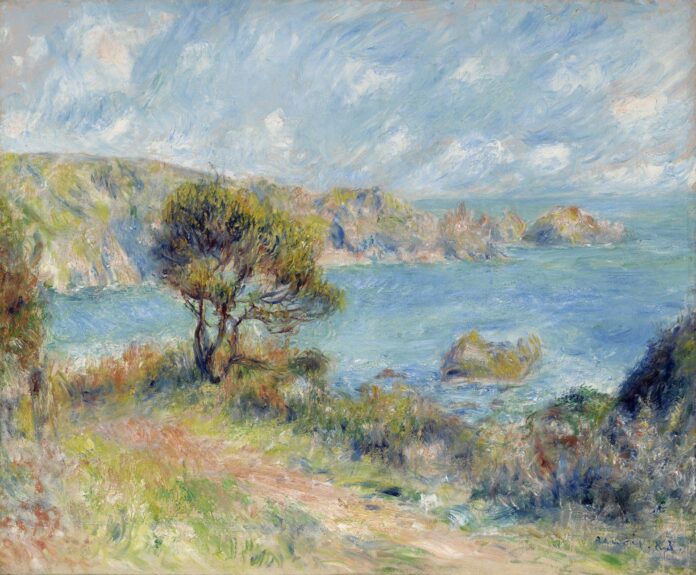The British island of Guernsey is arguably known better as a shadowy tax haven for the super-rich than for its arts. But a forthcoming travelling exhibition opening there this summer hopes to present a different side to the island—as a source of inspiration for the French Impressionist Pierre-Auguste Renoir.
The show Renoir in Guernsey, 1883 will focus on the 15 landscapes that the artist painted while on a five-week trip there, and for its Guernsey leg its organisers, led by the charity Art for Guernsey, have secured 12 of these works, including loans from London’s National Gallery (Bai du Moulin-Huet à Guernesey, 1883) and the Cincinnati Art Museum (Brouillard à Guernesey, 1883) as well as from private collections, facilitated in part by Christie’s. One of the works displayed, Rochers de Guernesey avec personnages (plage à Guernesey) (1883) was bought at Christie’s London for £443,250 (with fees) by a group of local collectors—including the Art for Guernsey founder David Ummels—in 2020.

First frame on the Renoir Walk showing the landscape that inspired the artist’s Baie du Moulin Huet à travers les arbres (Moulin Huet Bay through the trees) (1883)
Courtesy of Art for Guernsey
Before being shown at the island’s Candie Museum (30 September-15 December), the exhibition will open at the Musée des impressionnismes Giverny, France (14 July-10 September) whose reputation and connection to the Musée d’Orsay also helped to secure the loans. The show has been curated by the director of the Giverny museum, Cyrille Sciama, who is a long-time supporter of Art For Guernsey. In 2019, he travelled to the island to record talks on the artist’s connection to its landscape as part of the charity’s Renoir Walk programme. An initiative encouraging participants to follow in the artist’s footsteps, it framed Guernsey’s notably unchanged landscape to match Renoir’s paintings and accompanied them with Sciama’s talks.
Speaking of the show’s importance, Sciama says that Renoir’s stay in Guernsey was integral to the artistic development of a bored and stagnant Renoir. “The show is more than just 15 paintings inspired by Guernsey. His stay on the island gave him a sense of freedom that opened up his style.”

Renoir’s Marine Guernesey (1883) will be restituted to the heirs of Ambroise Vollard
© Wikimedia Commons
One painting that will be missing from the Guernsey leg of the exhibition is Marine Guernesey (1883). In February, the Musée d’Orsay was ordered by a Parisian administrative court to return the work to the heirs of the influential French dealer Ambroise Vollard. The painting was stolen during the Second World War and then sold to the Nazis. The painting was never planned for the Guernsey exhibition, although it will be present during the Giverny leg. “Almost two years ago, we were told by the curator that [the painting] cannot leave French territory because a justice decision was anticipated,” Ummels says.
The Candie exhibition will be part of a larger programme celebrating the 140th anniversary of Renoir’s trip. It will include shows and activities at the Priaulx Library, the Renoir Walk and the recently opened Art for Guernsey gallery in the island’s Old Quarter. The new gallery will rotate art from local collectors including works by Banksy, Thomas Gainsborough, Francisco de Goya, Andy Warhol and Renoir.
Art for Guernsey also runs a residency programme allowing artists to make work that is then exhibited in Guernsey. Nestled between the UK and France, Ummels cites the island’s unique position as an opportunity to create relationship with both countries. It is sentiment Sciama echoes. The importance of “tourism, culture and children” and the role art plays in supporting all is central to the exchange between the two areas. A mayoral ceremony is planned for the summer to officially recognise a partnership between the two locales, Sciama adds.
Of course, Giverny is already an art centre; home not only to the Impressionism museum but to the Fondation Claude Monet, as well as the home of the artist and the inspiration for many of his masterpieces. But for Guernsey, Ummels recognises the opportunity the exhibition—and its wider context—creates for a rebrand. “In the 19th century [Guernsey] was a destination for British and French artists to find inspiration”. Since then, the island has been in the business of granite, fruit, tourism and most notoriously tax avoidance, he continues. “I really believe in the island and the people here,” Ummels says. “I feel that art has a role to play in reconnecting the communities and giving us a chance to reintroduce ourselves to the UK, to France, to other countries and to give them a chance to see who we are.”

























